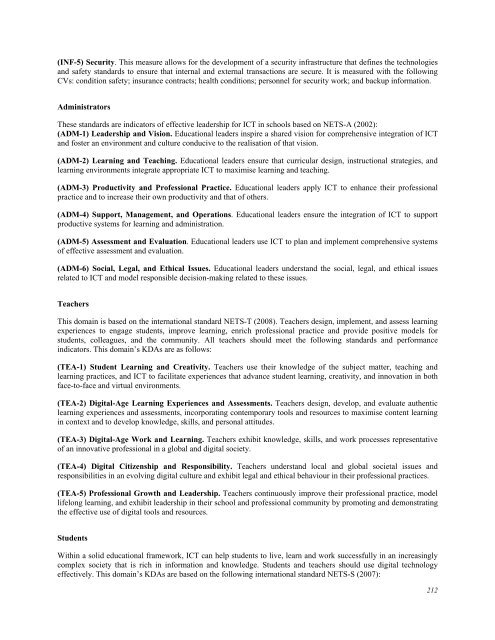A Maturity Model for Assessing the Use of ICT in School Education
A Maturity Model for Assessing the Use of ICT in School Education
A Maturity Model for Assessing the Use of ICT in School Education
You also want an ePaper? Increase the reach of your titles
YUMPU automatically turns print PDFs into web optimized ePapers that Google loves.
(INF-5) Security. This measure allows <strong>for</strong> <strong>the</strong> development <strong>of</strong> a security <strong>in</strong>frastructure that def<strong>in</strong>es <strong>the</strong> technologies<br />
and safety standards to ensure that <strong>in</strong>ternal and external transactions are secure. It is measured with <strong>the</strong> follow<strong>in</strong>g<br />
CVs: condition safety; <strong>in</strong>surance contracts; health conditions; personnel <strong>for</strong> security work; and backup <strong>in</strong><strong>for</strong>mation.<br />
Adm<strong>in</strong>istrators<br />
These standards are <strong>in</strong>dicators <strong>of</strong> effective leadership <strong>for</strong> <strong>ICT</strong> <strong>in</strong> schools based on NETS-A (2002):<br />
(ADM-1) Leadership and Vision. <strong>Education</strong>al leaders <strong>in</strong>spire a shared vision <strong>for</strong> comprehensive <strong>in</strong>tegration <strong>of</strong> <strong>ICT</strong><br />
and foster an environment and culture conducive to <strong>the</strong> realisation <strong>of</strong> that vision.<br />
(ADM-2) Learn<strong>in</strong>g and Teach<strong>in</strong>g. <strong>Education</strong>al leaders ensure that curricular design, <strong>in</strong>structional strategies, and<br />
learn<strong>in</strong>g environments <strong>in</strong>tegrate appropriate <strong>ICT</strong> to maximise learn<strong>in</strong>g and teach<strong>in</strong>g.<br />
(ADM-3) Productivity and Pr<strong>of</strong>essional Practice. <strong>Education</strong>al leaders apply <strong>ICT</strong> to enhance <strong>the</strong>ir pr<strong>of</strong>essional<br />
practice and to <strong>in</strong>crease <strong>the</strong>ir own productivity and that <strong>of</strong> o<strong>the</strong>rs.<br />
(ADM-4) Support, Management, and Operations. <strong>Education</strong>al leaders ensure <strong>the</strong> <strong>in</strong>tegration <strong>of</strong> <strong>ICT</strong> to support<br />
productive systems <strong>for</strong> learn<strong>in</strong>g and adm<strong>in</strong>istration.<br />
(ADM-5) Assessment and Evaluation. <strong>Education</strong>al leaders use <strong>ICT</strong> to plan and implement comprehensive systems<br />
<strong>of</strong> effective assessment and evaluation.<br />
(ADM-6) Social, Legal, and Ethical Issues. <strong>Education</strong>al leaders understand <strong>the</strong> social, legal, and ethical issues<br />
related to <strong>ICT</strong> and model responsible decision-mak<strong>in</strong>g related to <strong>the</strong>se issues.<br />
Teachers<br />
This doma<strong>in</strong> is based on <strong>the</strong> <strong>in</strong>ternational standard NETS-T (2008). Teachers design, implement, and assess learn<strong>in</strong>g<br />
experiences to engage students, improve learn<strong>in</strong>g, enrich pr<strong>of</strong>essional practice and provide positive models <strong>for</strong><br />
students, colleagues, and <strong>the</strong> community. All teachers should meet <strong>the</strong> follow<strong>in</strong>g standards and per<strong>for</strong>mance<br />
<strong>in</strong>dicators. This doma<strong>in</strong>’s KDAs are as follows:<br />
(TEA-1) Student Learn<strong>in</strong>g and Creativity. Teachers use <strong>the</strong>ir knowledge <strong>of</strong> <strong>the</strong> subject matter, teach<strong>in</strong>g and<br />
learn<strong>in</strong>g practices, and <strong>ICT</strong> to facilitate experiences that advance student learn<strong>in</strong>g, creativity, and <strong>in</strong>novation <strong>in</strong> both<br />
face-to-face and virtual environments.<br />
(TEA-2) Digital-Age Learn<strong>in</strong>g Experiences and Assessments. Teachers design, develop, and evaluate au<strong>the</strong>ntic<br />
learn<strong>in</strong>g experiences and assessments, <strong>in</strong>corporat<strong>in</strong>g contemporary tools and resources to maximise content learn<strong>in</strong>g<br />
<strong>in</strong> context and to develop knowledge, skills, and personal attitudes.<br />
(TEA-3) Digital-Age Work and Learn<strong>in</strong>g. Teachers exhibit knowledge, skills, and work processes representative<br />
<strong>of</strong> an <strong>in</strong>novative pr<strong>of</strong>essional <strong>in</strong> a global and digital society.<br />
(TEA-4) Digital Citizenship and Responsibility. Teachers understand local and global societal issues and<br />
responsibilities <strong>in</strong> an evolv<strong>in</strong>g digital culture and exhibit legal and ethical behaviour <strong>in</strong> <strong>the</strong>ir pr<strong>of</strong>essional practices.<br />
(TEA-5) Pr<strong>of</strong>essional Growth and Leadership. Teachers cont<strong>in</strong>uously improve <strong>the</strong>ir pr<strong>of</strong>essional practice, model<br />
lifelong learn<strong>in</strong>g, and exhibit leadership <strong>in</strong> <strong>the</strong>ir school and pr<strong>of</strong>essional community by promot<strong>in</strong>g and demonstrat<strong>in</strong>g<br />
<strong>the</strong> effective use <strong>of</strong> digital tools and resources.<br />
Students<br />
With<strong>in</strong> a solid educational framework, <strong>ICT</strong> can help students to live, learn and work successfully <strong>in</strong> an <strong>in</strong>creas<strong>in</strong>gly<br />
complex society that is rich <strong>in</strong> <strong>in</strong><strong>for</strong>mation and knowledge. Students and teachers should use digital technology<br />
effectively. This doma<strong>in</strong>’s KDAs are based on <strong>the</strong> follow<strong>in</strong>g <strong>in</strong>ternational standard NETS-S (2007):<br />
212
















